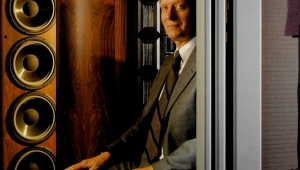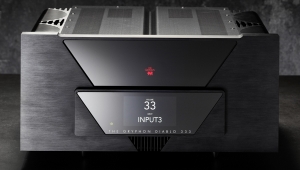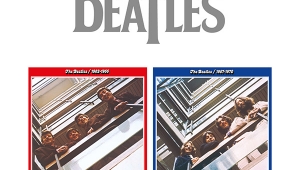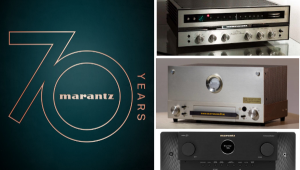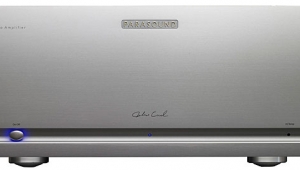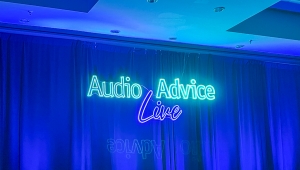| Columns Retired Columns & Blogs |
Analog vs. Digital at the 105th AES
Cats vs. dogs, Wile E. Coyote vs. Roadrunner, Spy vs. Spy, Analog vs. Digital. It seems that some battles will never end, and so it is with flux vs. bits in the professional recording industry. The Audio Engineering Society (AES) conventions dazzle showgoers with the latest audio recording and processing gear, mostly digital, and this year's show is no exception. The big buzz heard 'round the hall were higher sampling and quantization rates for future music formats such as DVD-Audio. But off-site, at the nearby ANA hotel (great choice of venue---just add LOG) in downtown San Francisco, key industry heavyweights were holding a meeting to discuss the future of analog recording technologies.
Organized by the Analog Option Coalition (AOC), the event, billed as a "Town Hall Meeting on the Future of Analog," took place September 28, and was attended by about 100 record producers, mastering engineers, equipment and tape vendors, studio owners, audio educators, and assorted press. Analog-loving audiophiles have been taking a digital beating for years; it was interesting to see how the recording industry is also feeling the pain.
First to speak from a panel of eight was Gerd Cyrener from BASF Pro Media. He pointed out that 90% of the coated tape sold is used for analog recording and archiving. As a counterpoint, Bruno Hochstrasser of Studer, manufacturer of the Mercedes of pro multitrack recorders and mastering decks, lamented that they sell only 50-60 of their high-end analog 24-track machines each year---almost all in the US, with none going to Asia and a few scattered throughout Europe. He stated that his company will support the format as long as they can sell a few machines---in fact, he noted that interest is up this last year---but added that it's becoming more difficult to maintain the analog end of the business.
Steve Smith from Quantegy (formerly Ampex) reported that demand for their analog tape products has remained strong, especially the 2" format, with 1/4" sales down somewhat. Quantegy purchased 3M's tape technology when 3M left the market, which gave Quantegy new prowess in binding techniques. As a result, Quantegy introduced a new analog tape called GP9, which, Smith claims, will archive longer than any tape they've made so far.
Next up were the testimonials from producers and mastering engineers. Alan Sides from OceanWay Recording (check the credits of some of your favorite albums---you'll see OWR listed as the studio) said that "my analog usage has increased; 80-90% of my 24-track sessions are analog, and 100% of the mastering is done to 1/2" analog tape." He also pointed out that DAT copies made for referencing typically fall apart, both as a faithful music-reproduction medium and as a physical format. "Analog will be with us for a long time," he concluded. Sides also talked a little about using Sony's new DSD format, intended for the Super Audio CD (at this point a rival to DVD-Audio). "I could not say it is better---it has pluses and minuses---but there is not a multitrack on the horizon, so it is not an option right now."
Joe Chiccarelli, a producer who has recorded a wide variety of recent music including Beck, Tori Amos, and Hole, agreed with Sides: "It will be a long while before digital replaces analog." He said that, when starting out, he found that only analog recordings could provide the bottom end that he liked; he primarily uses analog 16- or 24-track machines for his sessions.
The mastering engineers were next. Bob Ludwig of Gateway Mastering stated that 60-70% of his projects are all-analog, with DATs provided as backup. "We do compare the formats, and analog wins hands down the majority of the time," he said. Ludwig points out that until higher-resolution digital multitracks are more common, analog will dominate. He also hinted that he still prefers analog to 96kHz digital, and added, "We're still very much an analog world; we have six ways to play back an analog tape in our facility."
Bernie Grundman of Bernie Grundman Mastering agreed with Ludwig, and pointed out that 60% of his projects are mastered from analog---even in his Tokyo facility, where it used to be 0%. (Japan is a notoriously digital country when it comes to studio multitracking and mixing.) When making comparisons, Grundman said, "Digital always has a thinness about it, which I call 'skinny sound.' Analog has size, and usually always wins in my studio." Grundman, noting digital tapes' propensity to go bad quickly, warned the audience to make analog copies for archiving. "Analog tapes going back to the '50s still sound great. If you really want to preserve the sound, use analog."
Next were questions from the audience, and, after the usual testimonials, a voice erupted from the back of the room. Its owner exclaimed in no uncertain terms that, unlike the other speakers, he would not use a microphone in loudly stating that he was opting for pure analog. The voice belonged to audio equipment designer Tim de Paravicini, who was ready to defend a new analog tape format: 1" two-track. De Paravicini stated that, until digital hits around 24-bit/400kHz, he'll stick to analog, thank you very much. He reported that he's working with several other manufacturers, and that a 1" standard will soon emerge that he hopes will be used by quality-driven engineers around the world. De Paravicini also pointed out that, because he invented the format, that he could define it exactly as he liked, including a tape speed of 15ips---half the 30ips speed used for most high-end analog mixing these days. He claims that if the machines and tape are set up properly, the slower speed with 1" tape cannot be beat.
Interestingly, not much was said of recording for DVD-Audio, even though AOC moderator Bruce Borgerson suggested the topic as a discussion item; and editing projects on computer was roundly trounced by everyone present. Vinyl was championed several times, and analog equalizers uniformly praised. One gradually became aware that this room concentrated some of the most powerful audiophiles in the business. Let's hope they win the perpetual analog-vs.-digital battle without having to resort to undependable ACME dynamite.
- Log in or register to post comments
